My Wild Rice Turned Out Chewy Can I Cook It Again
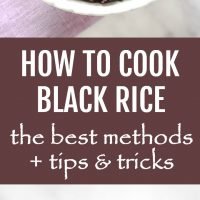
I had ever wanted to try black rice but never taken the time to do information technology until only recently. My local grocery store started selling it virtually 2 months agone, and I bought a package right away. To my surprise, there were no cooking instructions on the packaging, and since I had no idea how to cook black rice, I causeless that the standard ratio of 1 office rice and 2 parts water would piece of work just fine. However, it didn't turn out as well as I expected.
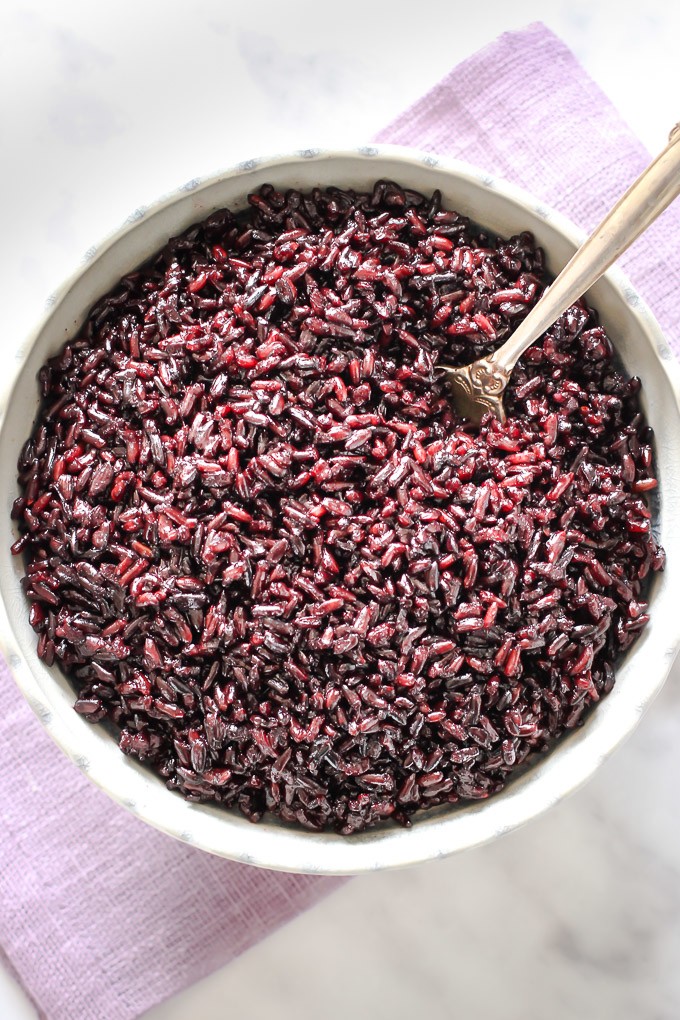
I really had to experiment quite a bit to observe the best ratio of rice to water. As I was doing my research, I also learned how to cook black rice using three different methods and found quite a few useful tips and tricks.
If you are new to cooking blackness rice, here are a few interesting facts about it…
What is Blackness Rice?
Black rice, also chosen royal rice, forbidden rice, and Chinese black rice is a blazon of whole-grain rice that is quite night in color. It tin can be completely blackness or more of a dark royal or burgundy with some multicolored kernels. When black rice is cooked, information technology turns dark purple.
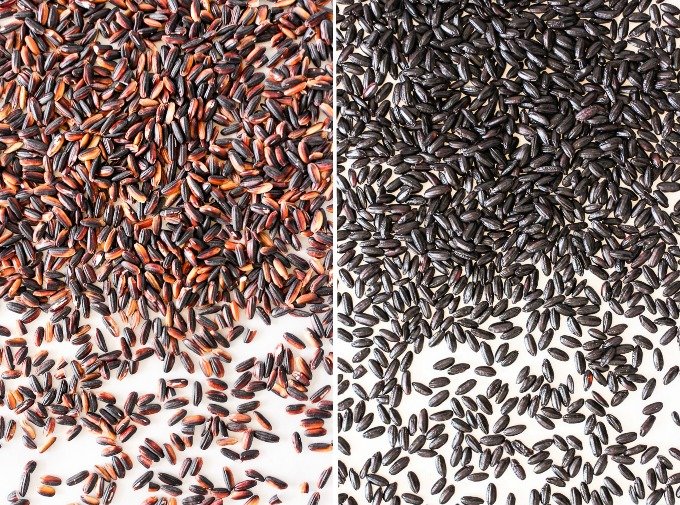
Uncooked black rice can be completely black or more of a night regal or burgundy with some multicolored kernels.
Why is Black Rice Black?
Black rice gets its dark color from the antioxidant called anthocyanin. It'southward the same nutrient that is constitute in many purple-colored fruits and vegetables such as blueberries and eggplant.
How Does Black Rice Taste?
Black rice tastes very similar to brown rice and is ofttimes described every bit having a "nutty" season. It's quite dense and chewy. Depending on the cooking method, black rice tin also be quite sticky.
Is Blackness Rice Nutritious?
Yes, black rice is very nutritious. It's high in antioxidants, poly peptide, and fiber and is a adept source of iron.
Is Black Rice and Wild Rice the Same Thing?
No, blackness rice and wild rice are quite unlike. They are grown and harvested in different ways. They also gustation differently and behave differently in cooking.
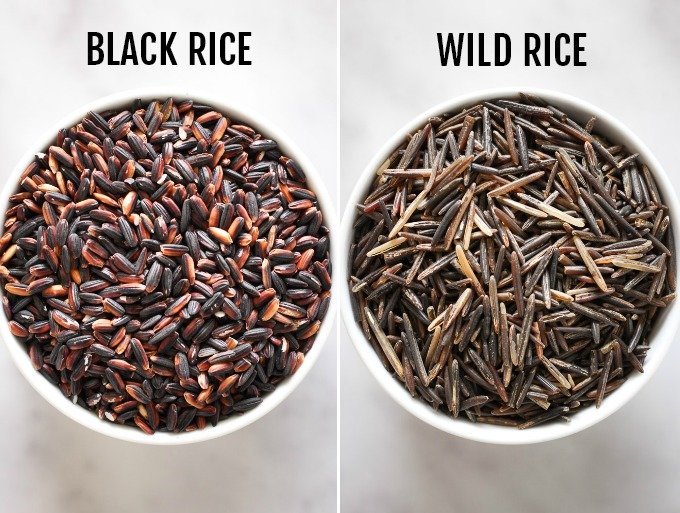
Black Rise (on the left) vs. Wild Rice (on the right)
What is the glycemic index of blackness rice?
The glycemic index of black rice is 43, and the glycemic load is 14.
Is Black Rice Gluten-Gratuitous?
Yes, black rice is gluten-gratuitous.
How practise You Serve Black Rice?
Black rice tin can exist served as a simple side dish simply similar you would serve white or brown rice.
Information technology makes an excellent base for grain and veggie bowls and grain salads. Information technology also tastes great in burritos and wraps. Since black rice is naturally gluey, it'southward perfect for sushi. Black rice is also frequently used to brand desserts and puddings.
For case, it would sense of taste great served with this Vegan Mushroom Goulash, these Healthy Turkey Meatballs, or this Pan Fried Rainbow Trout.
Is information technology better to pre-soak black rice before cooking?
Pre-soaking hard grains such as dark-brown or wild rice is a pop method of reducing the cooking time. Since black rice also takes a long time to cook, I decided to experiment with pre-soaking it to run across how it turns out. The results were quite surprising.
I found that pre-soaking for 1 hour didn't change the cooking time at all and didn't affect the taste or the texture of the cooked rice.
Pre-soaking the rice overnight only reduced the cooking time for v minutes but inverse the texture of the cooked rice quite a bit. The pre-soaked cooked blackness rice was clumping together, most of the kernels outburst open, and the rice became very sticky when it cooled.
Although pre-soaking black rice just to reduce the cooking time doesn't make much sense, it might still exist a useful pace to exercise for other reasons, for example, to brand it easier to digest.
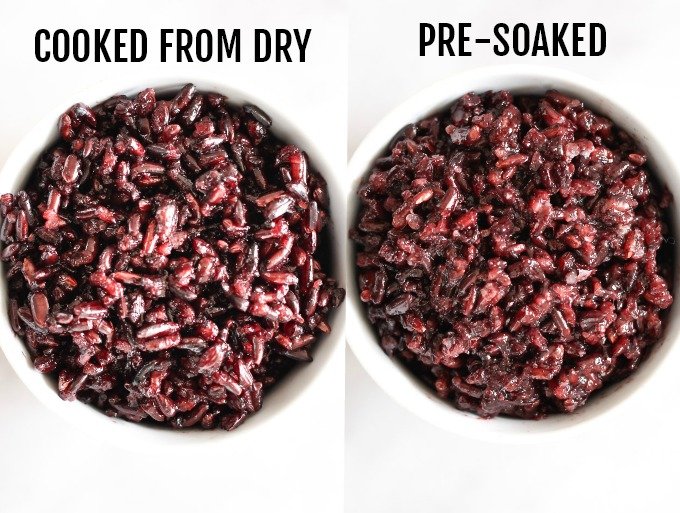
Blackness Rice Cooked from Dry vs. Pre-Soaked Cooked Black Rice
What to Keep in Mind When Cooking Blackness Rice:
- Blackness rice takes longer to cook than white rice, so plan accordingly.
- The purple pigment in the blackness rice is so strong that it will stain anything and everything. So, use glass or metal cookware and wipe your countertop immediately if you get whatsoever wet black rice or the imperial colored liquid on it. Too, make sure to protect your clothing. Black rice will also stain any nutrient information technology's cooked with.
How to Cook Black Rice: The Basic Methods
There are three basic techniques that can exist used for cooking nearly all difficult grains – the absorption method, the pasta method, and the pilaf method. Here is how you tin use these methods for cooking blackness rice:
Method # 1 – The Absorption Method
The assimilation method is the almost basic and popular method of cooking grains.
This technique requires the grain to be cooked in a specific quantity of liquid that should exist fully absorbed by the grain past the cease of cooking. When using the absorption method, y'all can likewise use goop instead of water to requite the dish more season.
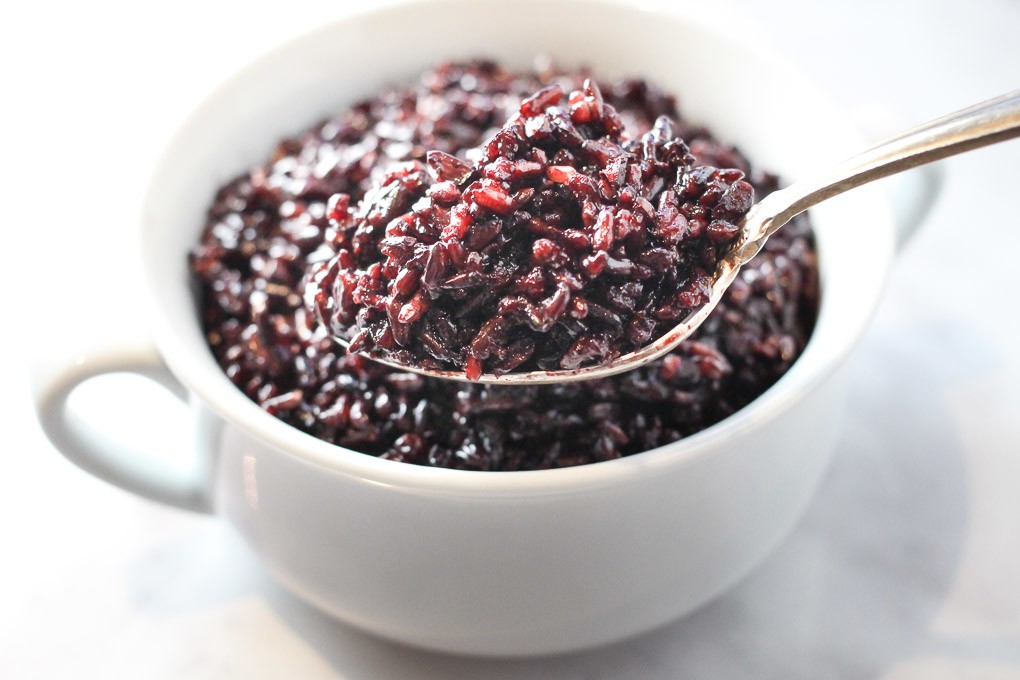
Black Rice Cooked Using Absorption Method
The Ingredients:
- two ane/iv loving cup h2o or broth
- 1 cup of black rice, rinsed
- 1/8 tsp of table salt (or to taste)
The Method:
To melt blackness rice using the absorption method, add water, and rinsed black rice to a bucket. Over medium-high heat, bring the water to a boil. Add the salt, reduce estrus, cover, and cook for well-nigh thirty-35 minutes.
Resist the urge to open up the lid too ofttimes to check on the rice because this will let a lot of steam out. Go on cooking until the rice is tender and chewy, and all water is absorbed. Have off the oestrus and let it stand up covered for near five to 10 minutes, then fluff with a fork and serve.
Troubleshooting:
If all the water has evaporated, but the rice is not fully cooked nonetheless, add 2 to three tablespoons of water and melt for 5 more than minutes.
Keep in Listen:
The fourth dimension and h2o to rice ratio required to cook the perfect black rice using the absorption method very much depend on the amount of water that evaporates during cooking. And this, in turn, depends on your cooking environment, such as the bucket and lid y'all are using, the humidity in your area, the distance you live in, etc. And then, you lot might need to experiment to determine the ratio and timing that works best for y'all.
Method # 2 – The Pasta Method
The pasta method of cooking hard grains isn't very pop, but information technology is super like shooting fish in a barrel and works very well with black rice.
This technique requires the grain to be cooked only like pasta in a large amount of water in a pot without a lid. When the grain is cooked, the water is discarded.
It's is an splendid method of cooking black rice because yous don't have to figure out and call back the exact ratio of water to rice.
It results in blackness rice with a very prissy non-sticky consistency. It'due south also more flexible every bit you can taste the rice during cooking to cheque for doneness. In addition, you don't take to worry about burning the rice or getting a hard crust at the bottom of the pan.
The disadvantages of this method are that you can just employ water and non broth for cooking as you lot volition be discarding it at the end, and some nutrients will also exist lost in the discarded water.
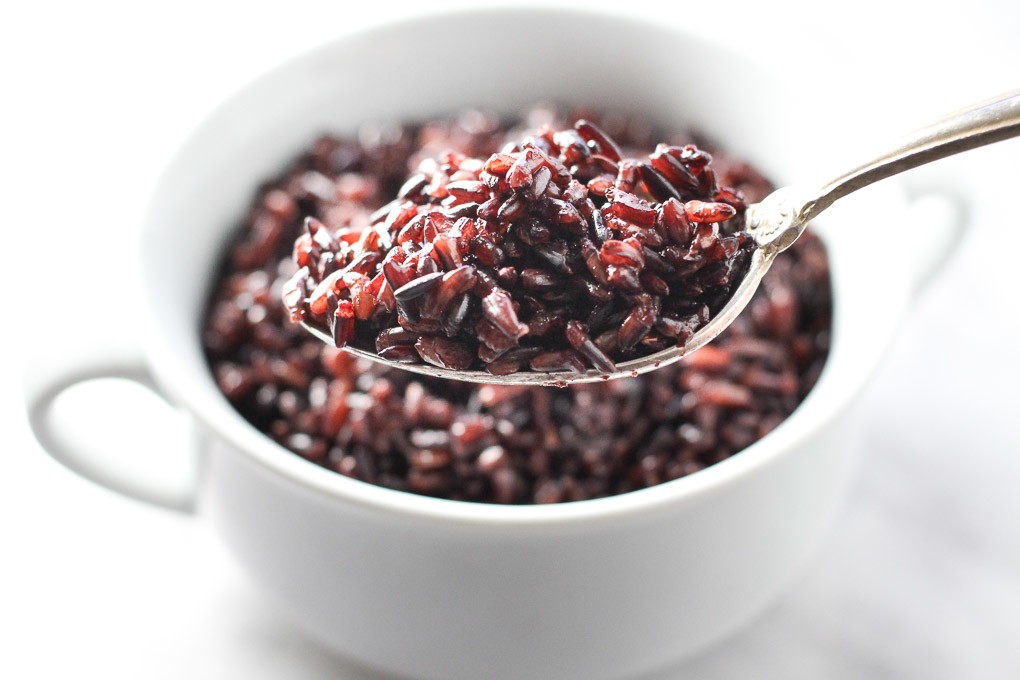
Blackness Rice Cooked Using Pasta Method
The Ingredients:
- half dozen cups of h2o
- ane tsp of salt
- ane cup of black rice, rinsed
The method:
To cook blackness rice using the pasta method, add the water, rinsed black rice, and salt to a large pot. Bring to a boil and cook for well-nigh thirty to 35 minutes until the rice is tender and chewy. Strain the black rice using a mesh colander.
Method # 3 – The Pilaf Method
In the pilaf method, grains are lightly toasted in oil with aromatics such as vegetables, herbs, and spices starting time and then simmered in water or stock.
To prepare a fragrant pilaf, you can use carrots, onion, shallots, garlic, ginger, fennel, celery, green peas, bay leaves, cumin, thyme, etc. You tin as well experiment past cooking the black rice pilaf with chicken or vegetable stock instead of h2o.
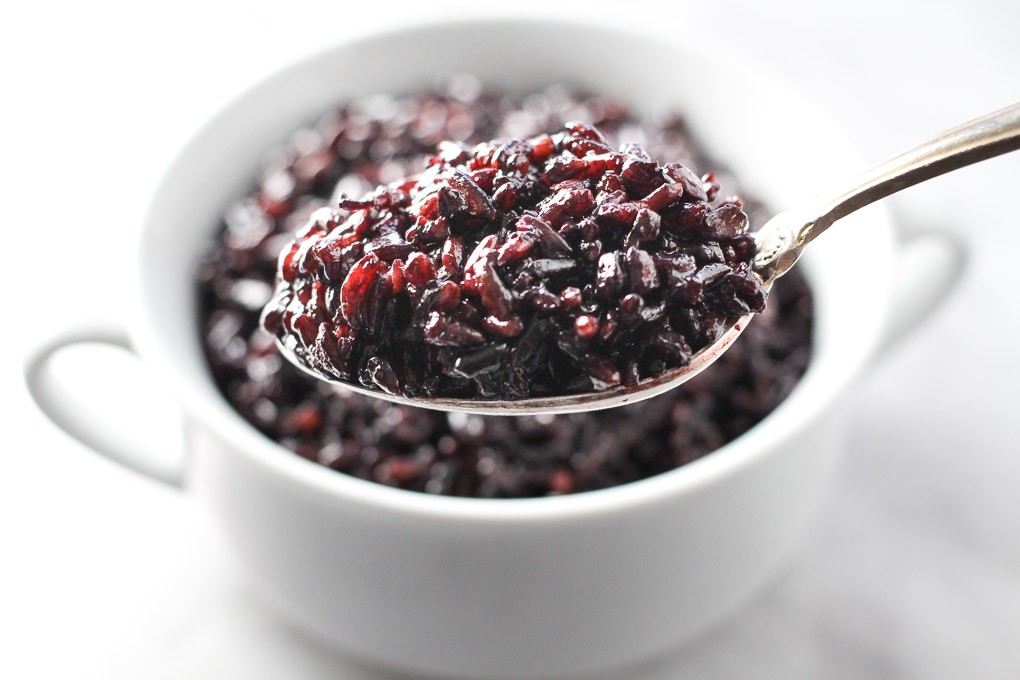
Black Rice Cooked Using Pilaf Method
The Ingredients:
- 1 Tbsp olive oil
- 1/four medium onion, thinly sliced
- 1 garlic clove, minced
- 1 cup black rice
- 2 1/four cup water
- ane/8 tsp salt (or to taste)
The Method:
In a saucepan, oestrus the oil over medium estrus. Add the onion and melt stirring occasionally until the onion is translucent for about 2 minutes, and then add the garlic and cook for nearly 30 seconds.
Add together the black rice and melt, stirring until the grains are well coated in oil and go fragrant. Then add the water and salt and bring to a eddy.
Reduce heat, embrace, and cook until the black rice is tender and chewy for well-nigh 30 to 35 minutes. Take the rice off the heat and permit it stand covered for about 5 to x minutes, then fluff with a fork and serve.
Troubleshooting:
If all the water has evaporated, only the rice is not fully cooked notwithstanding, add 2 to 3 tablespoons of water and melt for 5 more than minutes.
Continue in Listen:
The fourth dimension and water to rice ratio required to cook the perfect black rice pilaf very much depend on the amount of water that evaporates during cooking. And this, in plough, depends on your cooking surroundings, such as the saucepan and lid you are using, the humidity in your area, the altitude you alive in, etc. So, you might need to experiment to make up one's mind the ratio and timing that works best for you.
Now Information technology's Your Plow!
I've had a lot of fun testing these cooking methods and eating all that black rice, and now it'due south your turn! Please let us know in the comments beneath what is your favorite method of cooking blackness rice. Do y'all like information technology? Do you lot cook it frequently? And if you lot try whatsoever of the techniques described in this mail service, please give this recipe a five-star rating!
Ingredients
For the Absorption Method:
- 1 loving cup black rice, rinsed
- ii one/4 cup water
- one/8 tsp salt or to sense of taste
For the Pasta Method:
- 1 cup blackness rice, rinsed
- 6 cups water
- 1 i/2 tsp common salt or to sense of taste
For the Pilaf Method:
- ane Tbsp olive oil
- 1/iv medium onion, thinly sliced
- 1 garlic clove, minced
- one loving cup black rice
- ii i/4 cup h2o
- 1/8 tsp common salt or to taste
Instructions
For the Absorption Method:
- Add h2o and rinsed black rice to a bucket.
- Over medium-high heat, bring the water to a boil. Add the salt, reduce heat, cover and cook for about 30-35 minutes. (Don't open the lid as well oftentimes because this will let a lot of steam out.) Go along cooking until the rice is tender and chewy and all h2o is captivated.
- Have off the heat and let it stand covered for virtually v to ten minutes then fluff with a fork and serve.
For the Pasta Method:
- Add the water, rinsed black rice, and salt to a large pot. Bring to a boil and melt for about 30 to 35 minutes until the rice is tender and chewy.
- Strain the black rice using a mesh colander.
For the Pilaf Method:
- In a saucepan, heat the oil over medium heat. Add together the onion, and melt stirring occasionally until the onion is translucent for nigh 2 minutes then add the garlic and cook for about thirty seconds.
- Add together the black rice and melt, stirring until the grains are well coated in oil and become fragrant.
- Add the water and salt and bring to a eddy. Reduce oestrus, cover and melt until the black rice is tender and chewy for about xxx to 35 minutes.
- Accept the rice off the rut and let information technology stand up covered for about five to 10 minutes and then fluff with a fork and serve.
Notes
i. Troubleshooting for the absorption and pilaf methods:
- If all the water has evaporated but the rice is not cooked yet, add 2 to three tablespoons of water and cook for five more than minutes.
two. What to keep in listen for the absorption and pilaf methods:
- The time and water to rice ratio required to cook the perfect blackness rice very much depend on the amount of h2o that evaporates during cooking. And this, in turn, depends on your cooking environs such as the bucket and lid yous are using, the humidity in your surface area, the distance you lot live in, etc. Then, you might demand to experiment to determine the ratio and timing that works best for you.
3. Diet information is a rough estimate for one out of 4 servings of blackness rice cooked using assimilation method with i/8 tsp of common salt.
Nutrition Information
Yield 4 portions Serving Size i/four of recipe
Amount Per Serving Calories 160 Total Fat 0g Saturated Fat 0g Trans Fatty 0g Unsaturated Fat 0g Cholesterol 0mg Sodium 73.6mg Carbohydrates 34g Fiber 2g Sugar 0g Protein 3g
Nutrition facts provided on this website are an estimate and non guaranteed to be authentic. Please see a qualified health intendance provider for personalized diet advice and make sure that each of the ingredients is allowed in your diet.
Source: https://www.mariaushakova.com/2018/03/how-to-cook-black-rice/
0 Response to "My Wild Rice Turned Out Chewy Can I Cook It Again"
Post a Comment